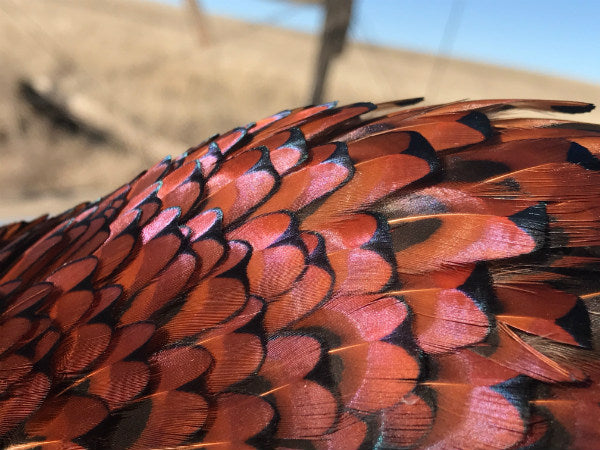The wind is right, blowing into your dog’s face. He works the cover with intent, dropping telltale hints that a bird is near.
His pace quickens, tail almost shivering in it’s excitement. You do your best to keep pace in the effort to give yourself a shot. The game is on.
The rooster rockets up into the air as if shot out of a cannon, hits the wind and banks hard left. Instinctually you shoulder your shotgun, follow your muscle memory and as quickly as the bird rose into the air, quiet takes over.
The dog returns with the prize. Stone dead, you revel in the weight of it all. The dog’s work, the good fortune in connecting cleanly with your game and the eventual meals you’ll share with friends and family.
This is the first time given to study your quarry. The legs built for speed and sneak, the audacious tail and so much more. All the color, all the shades, all the intricacy. In that moment, you really can see there’s just ridiculous beauty in the micro scale of every bird we hunt.

Beauty Inside Beauty
Upland bird hunting has always been a favorite amongst my father and I over the years. We are lucky to have a resilient wild bird population in Eastern Washington. If you knock on enough doors and know where the public land is, the opportunity is there.
What’s really struck me in the last several years is the beauty these birds possess. We as hunters spend so much time in the lead up to hunting, that when we have the game in hand, we often don’t stop for a minute to really appreciate what we’re looking at.
Take pheasants for example. Cartoon-like overtness mixed with a healthy dose of subtlety. An art project in real life, on a picture I have I can count 10 distinct colors on the head of a rooster alone.

When a turkey falls for my calls and comes into range, what really grabs my attention is the iridescence and variation of each bird. There’s beauty in a full tail fan but take a look at the breast feathers on a mature tom near or in hand. Blues coat the tips of each feather and the rest is a wash of subtle reds, greens, and blacks. Stare at a feather long enough and it’s as if the entire color wheel can be found as you change the light that hits it. At the risk of hyperbole, it’s darn near breathtaking.
Even the muted Canada Goose is a master in the art of subtle. Take a close look at the next honker you have on the ground. The story of each feather ridge, each fiber’s zipper, descending shades of grey to black. It’ll blow you away.
This awakening of appreciation was sparked by my growing obsession with fly tying.
Never wanting to waste anything that I take, I sit and stare at these harvested birds to determine which plumage will be of use.
I see a rabbit hole of beauty. The more I look, the deeper the story becomes
No pheasant is alike. One bird’s rump is awash in purples and browns, while the next one is dominated with greens and light blue. The fiery red to orange on each bird’s chest has wild variations from bird to bird.

I am in love with the plumage of grouse. Besides the amazing meal they provide, look at their breast feathers. White to brown to light brown, growing in intensity and darkness from neck to feet.
The sadistic Chukar, gentlemanly Quail and surprising Hungarian Partridge. Fat Mallards, whistling Widgeon and elusive Pintails. They all are flying art shows.
Taking a second look through the lens of the fly tier, there’s an aspect that adds deeper layers of intrigue to this puzzle. Many of these birds have life locked in their plumage that once attached to a hook, they live anew once in water.
Take the flanks of a Hungarian Partridge, for instance. These soft hackle fibers that come off the stem of each feather are utterly remarkable in the water and again on a micro level, it’s a sight to be seen.
We are all armed now with phones that allow us to zoom in at great detail to catch this missing story in bird hunting. By taking a little extra time to observe and soak in the beauty of the birds we take, it will only enhance our time in the outdoors. It signals our intent as land and game stewards. It strengthens our bond to the land and the game. It gives appreciation to the opportunities we have and the time we get to take afield. Then as you sit at your desk waiting for the next time outdoors, bring up that detailed picture and it will take you right back to that moment of observation.
It’s pretty darn awesome if you ask me. Next time when you’ve had a successful bird hunt, first take that tailgate down, birds lined up next to smiling dogs picture. You have to, it’s tradition! Then get in there with your phone or camera, zoom way in and see what stares back at you.
My guess? Unlimited beauty.

